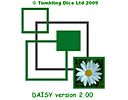- Digital Automated Identification SYstem (DAISY)
-
Digital Automated Identification SYstem (DAISY) 
Developer(s) Mark A. O'Neill Stable release 2.0.0 / December 1, 2010 Written in C[citation needed] Operating system Linux Platform IA-32 and x86-64 License Proprietary commercial software Website www.tumblingdice.co.uk/daisy Digital Automated Identification SYstem (DAISY) is an automated species identification system optimised for the rapid screening of invertebrates (e.g. insects) by non-experts (e.g. parataxonomists).
It was developed by Dr. Mark O'Neill during the early 1990s. Development was supported by funding from the Darwin Initiative in 1997[1] and BBSRC.[2] The intellectual property rights were acquired by O'Neill's company; Tumbling Dice Ltd, in February 2000[3] at the end of the grant funded Darwin Project. The systems is currently undergoing further development with a view to producing an exemplar which is web accessible and which can cope in near real time with groups (e.g. hawk moths) which contain several hundred taxa. On medium to high end PC server hardware (e.g. a blade server) an identification is possible in under 2 seconds for a 300 taxon group. Parallelisation of the critical DAISY classifier codes (using either bespoke FPGA technology or general purpose GPU programming technology such as CUDA) will give an order of magnitude increase in performance. This means that DAISY can be deployed to make real time identifications within groups containing thousands of taxa (e.g. true flies).
DAISY has been used in several research projects by O'Neill[4] and others, and featured in popular science TV and magazine articles. The project has also been the subject of a recent article in Science.[5]
Recently, the first DAISY installation capable of scaling to hundreds of taxa has been installed at Natural History Musueum in London. This server will offer both VNC and Web Service based interfaces and is able to offload compute intensive pattern matching operations onto an NVIDIA GPU programmed using CUDA. This installation is capable of providing identification to species in a 300 taxon dataset in less than 5 seconds in a multiple user environment.
-
Light trapping material for DAISY at Ulusaba Mpumalanga Province, South Africa
References
- ^ "Automating Insect Identification for Inventorying Costa Rican Biodiversity". Darwin Initiative. Defra. http://darwin.defra.gov.uk/project/6050/. Retrieved 15 December 2010.
- ^ "DAISY Overview" (PDF). Tumbling Dice. 2007. http://www.tumblingdice.co.uk/daisy/doverview.pdf. Retrieved 14 December 2010.
- ^ "Overview of the DAISY Project". Tumbling Dice. http://www.tumblingdice.co.uk/daisy/index.html. Retrieved 14 December 2010.
- ^ Watson, Anna T.; O'Neill, Mark A.; Kitching, Ian J. (2003). "A qualitative study investigating automated identification of living macrolepidoptera using the Digital Automated Identification SYstem (DAISY)". Systematics & Biodiversity 1: 287–300. doi:10.1017/S1477200003001208.
- ^ Reed, Sarah (2010). "Pushing DAISY". Science 25: 1628–1629. doi:10.1126/science.328.5986.1628.
External links
Categories:
Wikimedia Foundation. 2010.


